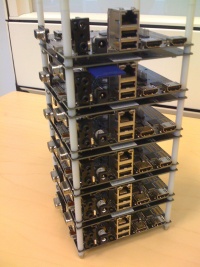< Architectures | ARM
Versatile Express
Technical Specifications
- 1 GHz Dual core Cortex A9 Processor (OMAP 4430-4460)
- 1 GB DDR2 RAM
- HDMI v1.3
- 10/100Mbit/s Ethernet
- 802.11 b/g/n WiFi
For more information on the Pandaboard visit their website.
Running Fedora on QEMU
This page will give you detailed instructions for running Fedora 17 GA through QEMU. There are two images to choose from using Versatile Express QEMU - with the XFCE desktop, the other providing a serial console (text based).
Download the image
The first step is to download the Fedora 17 image. The prebuilt images include kernels and can be booted without any additional steps or configuration.
- HFP Serial Console ImageKernel
- SFP Serial Console Image Kernel
- HFP XFCE Desktop Image
- SFP XFCE Desktop Image
Writing the Image
Linux Users
You can write the image to an SD card of your choosing but it does have to meet the minimum size requirements noted above (2GB for the serial image, 4GB for the XFCE Desktop). Connect the SD card to your computer and make note of the drive. To write the image to your SD card run the following command, changing the drive to the location of your SD card.
For the Serial Image:
xzcat Fedora-17-armhfp-panda-mmcblk0.img.xz > /dev/<location-of-your-SD-card>
For the XFCE Desktop:
xzcat Fedora-17-armhfp-panda-xfce-mmcblk0.img.xz > /dev/<location-of-your-SD-card>
Once completed run the below command to ensure the entire image is written to the card:
sync
Windows Users
- You will need to download Win32 Image Writer as well as a tool to extract the image such as 7-Zip.
- Once downloaded and installed right click on the disk image and select "7-Zip->Extract files here"
- Launch Win 32 Disk Imager and select the extracted disk image and the SD card you would like to write the files to. Click "Write". Be very careful during this step - all data on the selected drive will be lost!
Using Fedora on the Pandaboard
Connect the newly created media to your Pandaboard and power on. No further steps are required and your system should boot to a text based log in prompt (serial image) or to a graphical log in (XFCE Desktop image). The default root password is "fedoraarm". This should be changed immediately.
Known Issues
- Yum requires the system time be correct for HTTPS to function. If yum updates are not working check your clock.
- The tar.xz rootfs archives do not preserve SELinux information or file capabilities. If you use these to create your own filesystem image it is recommended that you switch SELinux to use warnings instead of enforcing for first boot, then relabel and reinstall packages that rely upon filesystem capabilities such as glibc-common and ping.
- Images are designed to be written to 2GB (console) or 4GB (xfce) SD cards. On first boot the partition will be resized to the maximum allowable amount. On the second boot the filesystem will be resized to fill the expanded partition. This works for SD cards, SATA Disks, and SSD drives.
- Known release issues
Additional Support
There are Fedora ARM users all around the globe - if you need assistance, would like to provide feedback or contribute to Fedora ARM please visit us on the IRC - we can be found in #fedora-arm on Freenode. You can also contact us on the mailing list - arm@lists.fedoraproject.org

